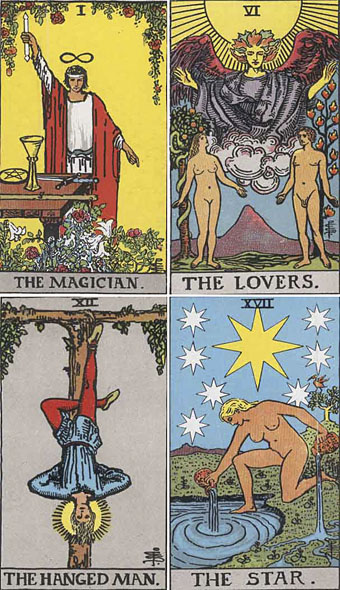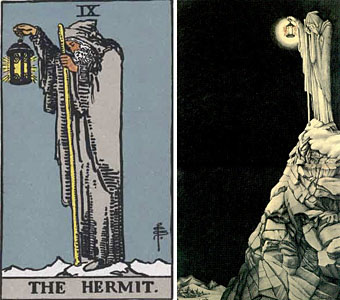
Following yesterday’s post about Frieda Harris’s Tarot designs, it only seems right to acknowledge the other major Tarot artist of the 20th century. Pamela Colman Smith has been overshadowed by her male mentor, Golden Dawn scholar AE Waite, even more than Frieda Harris whose name at least gets mentioned as much as Crowley’s in discussion of her paintings. US Games lists Smith and Waite’s so-called Rider-Waite Tarot of 1909 as “the world’s most popular tarot deck” and uses a silhouette of Smith’s design for The Fool as the company logo, yet it was years before I saw a credit for Smith as artist of this deck, her personal presence being reduced to a tiny monogram in the corner of each picture.

The Absurd ABC by Walter Crane (1874).
I’ve often thought of Smith’s deck as “the Art Nouveau Tarot” which it isn’t really—it’s more late Victorian in style, if anything—but it was created when Art Nouveau was at its height and has some of the character of the poster art of the period. Smith’s designs are incredibly striking in places, with the clarity of drawn archetypes, and her style possibly owes something to the books Walter Crane created for children in the 1870s and 1880s; the clean lines and bright colouring are very similar. In that respect, Smith’s deck might be more fittingly labelled “the Arts and Crafts Tarot.”

left: Pamela Colman Smith’s Hermit; right: Barrington Colby’s inner sleeve for Led Zeppelin IV.
Pamela Colman Smith also worked as a book illustrator but her other work is overshadowed completely by the popularity of the Rider-Waite cards. Her design for The Hermit was famously borrowed by Crowley obsessive Jimmy Page in 1971 for a gatefold illustration, View in Half or Varying Light by Barrington Colby, on Led Zeppelin IV. This use alone makes it possibly the most famous Tarot card in history (there was even a statue made of it for the now defunct Hard Rock Park Led Zeppelin roller coaster) but I doubt many people familiar with the image could name the original artist.
Happily, Ms Smith’s obscurity is gradually diminishing. US Games recently produced the Pamela Colman Smith Commemorative set for the 100th anniversary of the Rider-Waite deck, a package featuring a book of her artwork (including non-Tarot drawings), prints, postcards and a reprinted set of cards. A long overdue reappraisal but, as is always the case, it’s better late than never.
Mary K Greer’s Tarot blog has some excellent postings devoted to Pamela Colman Smith including this page which gathers links to sites containing further information about the artist’s life and work.
Elsewhere on { feuilleton }
• The illustrators archive
Previously on { feuilleton }
• Layered Orders: Crowley’s Thoth Deck and the Tarot
• William Rimmer’s Evening Swan Song
• The art of Cameron, 1922–1995

That’s it, man! Pamela is my muse in what concerns Tarot cards, being the first artist to give visual to the Minor arcana. As I told you, I use that deck also, alongsideThot and Marceille. But I have a special feeling with this and Crowley’s.
Hey, how about putting some more Tarot cards in your blog, for us buffers to travel high with the images?
All the best!
Beyond the traditional Tarot decks I’m not very familiar with the field. There’s been a huge explosion in deck designs over the past decade or so, it’s suddenly a very crowded world although I’ve yet to see many designs which I find attractive. I have a Giger set but they’re simply his Seventies paintings stuck into the Major Arcana. I also have the deck which came with the CD reissue of Tarot by the Cosmic Couriers but never liked Walter Wegmüller’s drawings, they’re naive in a bad way.
I had a book years ago full of different designs and there was a modern set in there which I liked, very stylised drawings in the manner of Ancient Egyptian art. I don’t have that book any more, however, so I’ve no idea who the artist was.
Seek and ye shalt find: the Ancient Egyptian Tarot I liked was created by René Schwaller de Lubicz in the 1920s. It’s been re-drawn a lot since but I prefer the simple designs of the original cards.
There was also the rather beautiful Aquarian Tarot Deck back in the 1970s
Thanks Anne, there’s another 1970s deck of note, mainly for the artist. The Tarot of the Witches was created by Fergus Hall and can be seen throughout the James Bond film, Live and Let Die. I like Hall’s unusual paintings although it seems some Tarot aficionados don’t, they regard them as too strange. Hall’s work adorned the sleeve of A Young Person’s Guide to King Crimson in 1975 which is where I first saw his name. The painting on the back is a variation of the one used for The World in the Major Arcana. I think it was only when I searched for him on the web some years ago I realised he’d also painted the Bond deck.
I have just discovered this conversation and am delighted to find it. I am a Tarot reader of only some three years’ standing and have made my focus for readings the Rider Waite deck, and now the Universal Waite deck because I like to see the extra detail and the brighter colours.
Altho I don’t know whether PCS or AEW was responsible for the actual characters and their historical costumes in the PCS deck, I am very impressed – as a medieval re-enactor – with the authenticity of the people’s fifteenth century garments. I am a costume maker myself and have researched the 1400 to 1500 period in some detail, and PCS’s drawings are nicely authentic. The majority of the cards set the scene with nobles and gentry in wealthy people’s clothes, usually with elaborate headwear (like chaperones and other elaborate hats) just as we see in Les Tres Riches Heures du Duc du Berry, which was painted around 1412.
PCS sets her cast of characters in beautiful patterned fabrics, like the art nouveau fabrics of Liberty and Morris, and heavily-lined and trimmed garments flowing along the ground as displays of their opulence and riches.
PCS certainly did her homework before drawing these clever designs, and of course the 19th century had already see the pre-Raphelites drawing on the 15th century to developing their gothic/romantic art works at the same time.
I was also interested in the similarity between PCS’s three of cups card and Botticelli’s The Three Graces.
I’ve always liked the symbolism of the tarot deck without buying into it as a belief system,and always get annoyed when it’s used in horror films and they ALWAYS show the ‘Death’ card as a portent of doom when it is an indicator of change rather than disaster (although they can sometimes be the same thing), similarly the ‘Devil’ and ‘Hanged Man’ cards (My personal favourite).
My mum is really into the tarot, and i was happy to find this page, as it made me go to Amazon and buy this set for her as a Birthday present. (£20.58 – Bargain)
http://www.amazon.co.uk/Pamela-Colman-Smith-Commemorative-Set/dp/1572816392/ref=sr_1_1?ie=UTF8&s=books&qid=1273303711&sr=8-1
Now you’ve made me dig out my Tarot books – a couple of good ones for the casual reader;
Alfred Douglas ‘The Tarot, The Origins, Meaning and Uses of the Cards’ Illustrations by David Sheridan. The illustrations are a bit cartoony/ ’70s (it was1st published in 1974), but the text is interesting – linking other belief systems into the traditional ‘reading’ of the cards similar to the ‘Jungian Archetype’ concept. For instance he links The Hanged Man with the Sumerian god Attis and the Norse god Odin.
It also has some nice photos of rare packs going back to the 18th century.
P D Ouspensky ‘The Symbolism of the Tarot’. Dreadful text but nice reproductions of the Major Acarna from the Pamela Colman Smith deck.
Both these titles have gone through various editions and can be picked up pretty cheaply on the internet. I wouldn’t recommend spending over £5.00 on either of them, they’re nice to have around, but not exactly vital.
I’ve not been very lucky with Tarot books. I used to have the Alfred Douglas book but one of my sisters borrowed it and it vanished. I think Sheridan’s designs were available as a card set for a while. Then I had another book in the Academy Art Editions series from the 1970s which showed different designs through the ages. A friend borrowed that and I haven’t seen it since.
Go here and get it again for £3.00 – £4.00 secondhand.
http://www.amazon.co.uk/s/ref=nb_sb_noss?url=search-alias%3Daps&field-keywords=Alfred+Douglas+tarot&x=0&y=0
wow it is a nice,i like it, and will back for reply
Somebody necessarily support to make seriously articles I may state. That may be the extremely first time I frequented your web page and to this point? I surprised with the research you made to make this actual put up wonderful. Amazing task!